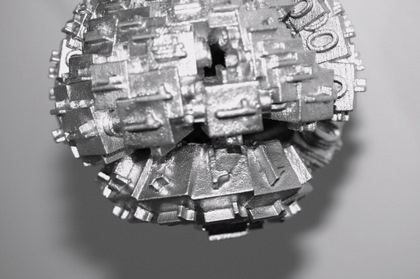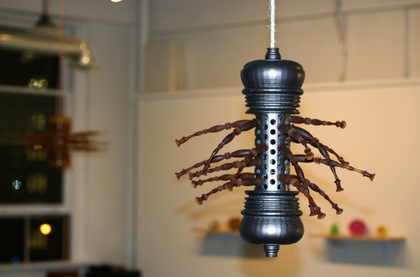Imagine a machine that has the power to create something out of thin air. This might sound like science fiction, but actually a process known as rapid prototyping has been around since the mid ‘80s. The technology is widely utilized by the medical, automobile and manufacturing industries (not to mention the military and NASA). This month at Flood Gallery electronic media artist Gene Felice demonstrates what happens when such technology gets caught up in the visual-arts realm.

Of course it’s a tad simplistic to say that rapid prototyping is the creation of things “out of thin air.” Actually, models are first mapped out using CAD software, and transformed into thin, virtual, horizontal cross-sections. The digital files containing all the code of these models are then transferred to a 3D printer which “prints” the object on an X and Y axis (like a normal printer), as well as up and down on a Z axis. Through the use of materials like high-resin epoxy, polymer and cellulose powder, a model materializes.
“It’s only recently that everyday people have had access to this technology,” says Felice, who says that outsourced information has enabled DIY versions of the machines to be constructed. It’s only a matter of time, says Felice, before the technology becomes readily available. “It’s just like CD burners or cell phones,“ says Felice, “At first only a few people had them and now they’re household items.”
Felice created the sculptures for his show, A Rapid Progression, two years ago when he had access to rapid prototype technology as a teacher at Ohio State University. “I felt like a mad scientist in a laboratory making all these little creatures,” says Felice referring to his futuristic forms inspired by concepts of cellular mutation and the ways that biology and technology adapt over time. “I was dealing with a family member who had died of cancer. I wanted to understand these forces that made his own body turn against itself.”

Beginning with sketches on paper, Felice drew up his designs on his computer. The code was then transferred to an additive resin-based 3D printer, which created forms that Felice later painted and embellished himself. His “Vessels” are remarkable in their detail, and it’s curious to wonder how a craftsperson might have created the designs using traditional methods like glassblowing or woodcarving.
Through the file transfer process some of the forms actually “mutated.” Intrigued by the outcome, Felice included them into his exhibit. His Clone series were originally supposed to be vases, but ended up resembling more tubular forms. A blue creature called “Mutation” projects glass spines from its decentered core, while “Remains” appears as an unfortunate organism that spontaneously exploded and is now covered in its own liquid contents.
Felice, who is known for his interactive and multimedia installations, also rigged up solar panels and a bicycle to provide the energy for lights and sound in the gallery. A form that hangs on one side of the gallery actually contains a microphone that plays through a stereo hidden inside a vessel on the other side of the gallery.

“I don’t think new forms of technology should replace old forms of technology” says Felice. “I like to combine them into wonderful new hybrids.“ In 2008, Felice received a grant from the Media Arts Project for his ambitious multimedia installation, The Screen Doors of Perception, which combined earthen and bamboo structures with digital and analog technologies. “In this day and age everything gets reconfigured, reappropriated and reassembled all the time,“ says Felice. “We’re all a part of this remix culture.”
A Rapid Progression will be on display at Flood Gallery in the Phil Mechanic Building through Oct. 21.



Before you comment
The comments section is here to provide a platform for civil dialogue on the issues we face together as a local community. Xpress is committed to offering this platform for all voices, but when the tone of the discussion gets nasty or strays off topic, we believe many people choose not to participate. Xpress editors are determined to moderate comments to ensure a constructive interchange is maintained. All comments judged not to be in keeping with the spirit of civil discourse will be removed and repeat violators will be banned. See here for our terms of service. Thank you for being part of this effort to promote respectful discussion.